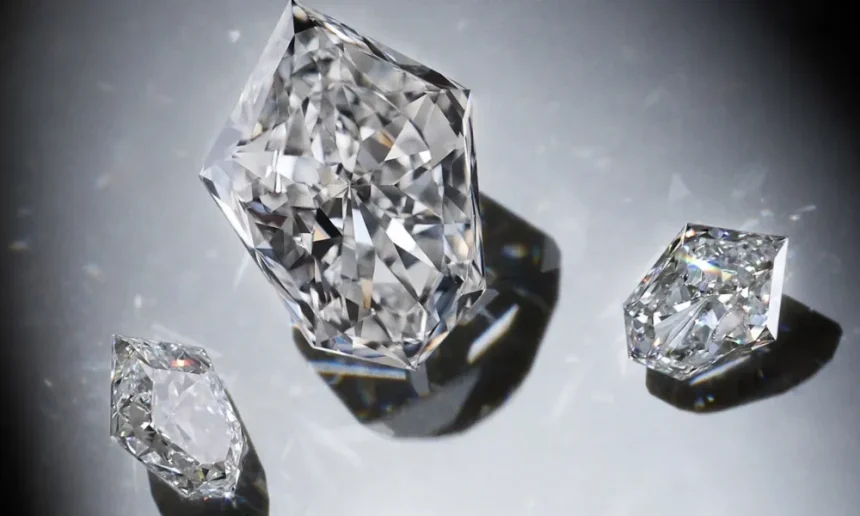Have you ever wondered if science could recreate one of nature’s most precious treasures? The answer lies in the fascinating world of lab grown diamond, a revolutionary advancement that’s transforming the jewelry industry as we know it. These remarkable gems represent the perfect marriage of cutting-edge technology and timeless beauty, offering consumers an ethical, sustainable, and economically viable alternative to traditionally mined diamonds.
Lab-grown diamonds have emerged as a game-changer in the luxury market, challenging long-held beliefs about what makes a diamond truly valuable. As consumers become increasingly conscious of environmental impact and ethical sourcing, these laboratory-created gems are gaining unprecedented popularity among millennials and Gen Z buyers who prioritize sustainability without compromising on quality or beauty.
What Are Lab-Grown Diamonds?
Lab-grown diamonds, also known as synthetic diamonds, cultured diamonds, or man-made diamonds, are genuine diamonds created in controlled laboratory environments rather than deep within the Earth’s crust. Despite their artificial origin, these diamonds possess identical chemical, physical, and optical properties to their naturally occurring counterparts. They’re not diamond simulants like cubic zirconia or moissanite – they are real diamonds, composed of pure carbon atoms arranged in the same crystal lattice structure that gives natural diamonds their exceptional hardness and brilliance.
The fundamental difference between lab-grown and natural diamonds lies solely in their origin story. While natural diamonds formed billions of years ago under extreme pressure and temperature conditions deep within the Earth, lab-grown diamonds are created in a matter of weeks using advanced technological processes that replicate these same conditions. This controlled environment allows scientists to produce diamonds with remarkable consistency and quality, often exceeding the clarity and color grades found in natural stones.
The Science Behind Diamond Creation
Understanding how lab-grown diamonds are created requires delving into the fascinating science of carbon crystallization. Diamonds form when carbon atoms bond together in a specific three-dimensional arrangement called a diamond cubic crystal structure. This arrangement is what gives diamonds their legendary hardness, rating 10 on the Mohs scale, making them the hardest naturally occurring substance on Earth.
In laboratory settings, scientists recreate the extreme conditions that naturally occur deep within the Earth’s mantle – temperatures exceeding 1,000 degrees Celsius and pressures of approximately 5 gigapascals. These conditions force carbon atoms to arrange themselves in the diamond structure rather than forming graphite, which is carbon’s more stable form under normal conditions. The precision of modern laboratory equipment allows for incredible control over these variables, resulting in diamonds with predetermined characteristics.
Chemical Composition and Structure
Lab-grown diamonds share the exact same chemical formula as natural diamonds: pure carbon (C). The carbon atoms are arranged in a face-centered cubic crystal structure, with each carbon atom bonded to four others in a tetrahedral arrangement. This structure is responsible for diamonds’ exceptional properties, including their unmatched hardness, high refractive index, and thermal conductivity.
The beauty of lab-grown diamonds lies in the fact that they exhibit the same optical properties that make natural diamonds so captivating. They display the same fire, brilliance, and scintillation that diamonds are famous for. The way light enters, reflects, and exits the diamond is identical, creating the same mesmerizing sparkle that has captivated humanity for centuries.
How Are Lab-Grown Diamonds Made?
The creation of lab-grown diamonds involves sophisticated technological processes that have been refined over decades of research and development. Two primary methods dominate the industry: High Pressure High Temperature (HPHT) and Chemical Vapor Deposition (CVD). Each method has its unique advantages and produces diamond with slightly different characteristics, though both result in genuine diamonds that are virtually indistinguishable from natural stones.
High Pressure High Temperature (HPHT) Method
The HPHT method was the first commercially successful technique for creating lab-grown diamonds, developed in the 1950s. This process closely mimics the natural formation of diamonds by subjecting carbon to extreme pressure and temperature conditions. The process begins with a small diamond seed, which serves as the foundation for crystal growth. This seed is placed in a specialized chamber along with a carbon source, typically graphite, and a metal catalyst such as iron, nickel, or cobalt.
The chamber is then subjected to pressures of approximately 5-6 gigapascals and temperatures ranging from 1,300 to 1,600 degrees Celsius. Under these extreme conditions, the carbon dissolves into the molten metal catalyst and then precipitates onto the diamond seed, gradually building up layer by layer to form a larger diamond crystal. This process typically takes several days to weeks, depending on the desired size of the final diamond.
HPHT diamonds often exhibit certain characteristics that can help gemologists identify their laboratory origin. They may show distinctive growth patterns, metal inclusions from the catalyst, or specific fluorescence patterns under ultraviolet light. However, these identifying features are typically only visible to trained professionals using specialized equipment.
Chemical Vapor Deposition (CVD) Process
The CVD method represents a more recent advancement in diamond synthesis technology, gaining popularity due to its ability to produce exceptionally pure diamonds with fewer inclusions. This process involves breaking down carbon-containing gases in a vacuum chamber using plasma or hot filament activation. The most commonly used gas mixture consists of methane and hydrogen, though other carbon-containing gases can be employed.
In the CVD process, the gas mixture is introduced into a vacuum chamber containing a diamond seed substrate. The chamber is then heated to temperatures around 800-1,000 degrees Celsius, significantly lower than the HPHT method. Plasma or hot filament activation breaks down the gas molecules, allowing carbon atoms to deposit onto the diamond seed in a controlled manner. This layer-by-layer deposition creates a diamond with exceptional purity and clarity.
CVD diamonds often exhibit superior quality in terms of clarity and color compared to HPHT diamonds. They typically have fewer inclusions and can achieve higher color grades, making them particularly attractive for jewelry applications. The controlled nature of the CVD process also allows for the creation of diamonds with specific properties, such as enhanced conductivity for industrial applications.
Comparison of Production Methods
Both HPHT and CVD methods produce genuine diamonds, but they each have distinct advantages and characteristics. HPHT diamonds tend to be produced more quickly and can achieve larger sizes more efficiently, making them cost-effective for certain applications. However, they may contain metal inclusions and exhibit more variation in color and clarity.
CVD diamonds, while taking longer to produce, offer superior control over the final product’s properties. They typically achieve higher clarity grades and can be produced with exceptional color consistency. The CVD process is also more environmentally friendly, consuming less energy and producing fewer waste products compared to HPHT synthesis.
Lab-Grown vs. Natural Diamonds: The Ultimate Comparison
The debate between lab-grown and natural diamonds has been a hot topic in the jewelry industry, with passionate advocates on both sides. Understanding the similarities and differences between these two types of diamonds is crucial for making an informed purchasing decision. While both are genuine diamonds with identical chemical and physical properties, there are subtle distinctions that may influence your choice.
Physical Properties and Characteristics
From a scientific standpoint, lab-grown and natural diamonds are virtually identical. Both score 10 on the Mohs hardness scale, exhibit the same refractive index of 2.42, and possess identical thermal conductivity properties. They share the same crystal structure, chemical composition, and optical properties that create the brilliant sparkle diamonds are famous for.
The most significant difference lies in their formation process and the time required for creation. Natural diamonds formed over billions of years under specific geological conditions, while lab-grown diamonds are created in a matter of weeks using controlled processes. This difference in formation time can sometimes result in subtle variations in crystal structure or inclusion patterns that trained gemologists can identify using specialized equipment.
Lab-grown diamonds often exhibit superior quality characteristics compared to natural diamonds. Because they’re created in controlled environments, laboratory diamonds frequently achieve higher clarity grades with fewer inclusions, more consistent color grades, and better overall symmetry. This controlled production process eliminates many of the imperfections that commonly occur in natural diamond formation.
Visual Differences and Detection
To the naked eye, lab-grown and natural diamonds are completely indistinguishable. Both exhibit the same fire, brilliance, and scintillation that make diamonds so captivating. Even experienced jewelers cannot visually differentiate between lab-grown and natural diamonds without specialized testing equipment.
Professional gemologists use advanced instruments to identify lab-grown diamonds, including photoluminescence spectroscopy, which detects specific emission patterns unique to each type. Some lab-grown diamonds may exhibit distinctive fluorescence patterns under ultraviolet light, while others might show microscopic growth patterns that differ from natural stones. However, these identifying features are only visible to trained professionals using specialized equipment and are not apparent to consumers during normal wear.
Durability and Longevity
Both lab-grown and natural diamonds offer identical durability and longevity. They’re equally resistant to scratching, chipping, and general wear, making them suitable for everyday jewelry pieces like engagement rings. The hardness and toughness properties that make natural diamonds so durable are exactly replicated in lab-grown diamonds, ensuring they’ll maintain their beauty and structural integrity for generations.
The myth that lab-grown diamonds are somehow less durable or will deteriorate over time is scientifically unfounded. Since they possess the same crystal structure and chemical composition as natural diamonds, they exhibit identical physical properties and will last just as long with proper care and maintenance.
Environmental Impact and Sustainability
One of the most compelling arguments for choosing lab-grown diamonds is their significantly reduced environmental impact compared to traditional diamond mining. As environmental consciousness grows among consumers, the sustainability factor has become a major driving force in the lab-grown diamond market’s expansion.
Carbon Footprint Comparison
Lab-grown diamonds typically have a dramatically smaller carbon footprint compared to mined diamonds. While the exact figures vary depending on the production method and energy sources used, studies suggest that lab-grown diamonds can produce up to 90% fewer carbon emissions than mined diamonds. This reduction is primarily due to the elimination of large-scale mining operations, which require massive amounts of earth movement, heavy machinery operation, and transportation of materials.
The energy consumption for producing lab-grown diamonds is concentrated in the manufacturing process itself, typically lasting only a few weeks. In contrast, diamond mining involves years of extraction, processing, and transportation activities that collectively contribute to a much larger carbon footprint. Additionally, many lab-grown diamond facilities are increasingly powered by renewable energy sources, further reducing their environmental impact.
Mining vs. Laboratory Production
Traditional diamond mining has significant environmental consequences that extend far beyond carbon emissions. Mining operations often require the removal of hundreds of tons of earth to recover a single carat of diamonds, leading to habitat destruction, soil erosion, and water contamination. Large-scale mining operations can permanently alter landscapes and disrupt local ecosystems.
Laboratory production of diamonds occurs in controlled indoor environments that don’t require land excavation or habitat disruption. The physical footprint of a diamond laboratory is minimal compared to a mining operation, and the environmental impact is largely limited to energy consumption rather than ecosystem destruction.
Ethical Considerations
Beyond environmental concerns, lab-grown diamonds address many ethical issues associated with traditional diamond mining. The diamond industry has historically been plagued by concerns about “conflict diamonds” or “blood diamonds” – stones mined in war zones and sold to finance armed conflicts. While certification programs like the Kimberley Process have improved the situation, concerns about labor conditions and community displacement in mining regions persist.
Lab-grown diamonds completely eliminate these ethical concerns by removing the human element from the extraction process. They offer consumers the peace of mind that comes with knowing their purchase doesn’t contribute to exploitative labor practices or conflict financing.
Economic Advantages of Lab-Grown Diamonds
The economic benefits of lab-grown diamonds extend beyond simple cost savings, offering consumers better value and enabling jewelers to create more elaborate designs at accessible price points. Understanding these economic advantages can help consumers make informed decisions about their diamond purchases.
Cost Savings and Value Proposition
Lab-grown diamonds typically cost 30-50% less than comparable natural diamonds, representing significant savings for consumers. This price difference allows buyers to either save money on their purchase or invest in a larger, higher-quality stone for the same budget. For example, a couple shopping for an engagement ring might be able to afford a 2-carat lab-grown diamond for the same price as a 1-carat natural diamond of similar quality.
The cost savings stem from the more efficient production process and shorter supply chain involved in creating lab-grown diamonds. Traditional diamond mining involves extensive exploration, extraction, processing, and multiple intermediaries before reaching consumers. Lab-grown diamonds bypass many of these steps, resulting in a more direct path from production to consumer.
Market Trends and Pricing
The lab-grown diamond market has experienced remarkable growth, with prices continuing to become more competitive as production techniques improve and scale increases. Industry reports indicate that the lab-grown diamond market is expected to grow at a compound annual growth rate of over 20% through the next decade, driven by increasing consumer acceptance and improved technology.
This growth has led to greater price stability and predictability compared to the natural diamond market, which can be subject to supply disruptions and geopolitical factors. As production capacity increases and technology advances, lab-grown diamonds are becoming even more affordable while maintaining consistent quality standards.
Quality and Certification Standards
Lab-grown diamonds are subject to the same rigorous grading and certification standards as natural diamonds, ensuring consumers receive accurate information about their purchase. Understanding these standards is crucial for making informed decisions and ensuring you’re getting the quality you expect.
Grading Systems and Certificates
Major gemological institutes, including the Gemological Institute of America (GIA), the International Gemological Institute (IGI), and the American Gem Society (AGS), all provide grading services for lab-grown diamonds. These organizations use the same 4Cs grading system (Cut, Color, Clarity, and Carat weight) that’s used for natural diamonds, ensuring consistency and standardization across the industry.
Lab-grown diamond certificates clearly identify the stone’s origin and include all relevant quality information. These certificates provide the same level of detail and accuracy as natural diamond certificates, giving consumers confidence in their purchase. The grading process for lab-grown diamonds is equally rigorous, with gemologists examining each stone under controlled conditions to assess its characteristics.
Industry Recognition and Acceptance
The jewelry industry has increasingly embraced lab-grown diamonds, with major retailers and luxury brands adding them to their offerings. This acceptance has been driven by consumer demand and the recognition that lab-grown diamonds represent a legitimate and valuable category within the fine jewelry market.
Professional jewelers and gemologists have developed expertise in working with lab-grown diamonds, ensuring that consumers receive the same level of service and craftsmanship regardless of their diamond choice. This industry acceptance has also led to improved standards and practices throughout the lab-grown diamond supply chain.
Popular Applications and Uses
Lab-grown diamonds have found widespread acceptance across various applications, from traditional fine jewelry to cutting-edge industrial uses. Their versatility and consistent quality make them suitable for diverse purposes.
Engagement Rings and Wedding Jewelry
Engagement rings represent the largest market segment for lab-grown diamonds, with many couples choosing them for their combination of beauty, value, and ethical considerations. The ability to purchase a larger or higher-quality stone within the same budget has made lab-grown diamonds particularly attractive to younger consumers who value both aesthetics and responsible consumption.
Wedding jewelry, including matching bands and anniversary pieces, has also embraced lab-grown diamonds. The consistency and quality control possible with laboratory production make it easier to create matched sets and ensure uniformity across multiple pieces.
Fashion and Statement Pieces
The affordability of lab-grown diamonds has opened up new possibilities for fashion jewelry and statement pieces. Designers can incorporate larger diamonds or multiple stones into their creations without pricing them out of reach for most consumers. This accessibility has led to more creative and bold designs that showcase diamonds in innovative ways.
Fashion-forward consumers appreciate the ability to own substantial diamond jewelry without the premium associated with natural stones. This has led to increased demand for diamond tennis bracelets, cocktail rings, and other statement pieces that make maximum visual impact.
Industrial Applications
Beyond jewelry, lab-grown diamonds have important industrial applications due to their exceptional properties. Their hardness, thermal conductivity, and electrical properties make them valuable for cutting tools, electronic components, and high-performance applications where natural diamonds would be prohibitively expensive.
The ability to create diamonds with specific properties through controlled production processes has opened up new industrial possibilities. Scientists can now produce diamonds with enhanced conductivity, specific colors, or other characteristics tailored to particular applications.
Common Myths and Misconceptions
Despite their growing popularity, lab-grown diamonds are still subject to various myths and misconceptions that can influence consumer perceptions. Addressing these misconceptions is important for making informed decisions.
Addressing Quality Concerns
One common misconception is that lab-grown diamonds are somehow inferior in quality to natural diamonds. This belief is scientifically unfounded, as lab-grown diamonds possess identical chemical, physical, and optical properties to natural stones. In fact, the controlled production environment often results in higher quality diamonds with fewer inclusions and better color consistency.
Another quality-related myth suggests that lab-grown diamonds will deteriorate over time or lose their sparkle. Since they have the same crystal structure and properties as natural diamonds, they will maintain their beauty and integrity for generations with proper care.
Investment Value Questions
Some consumers worry about the investment value of lab-grown diamonds compared to natural stones. While it’s true that lab-grown diamonds may not appreciate in value like rare natural diamonds, most diamond purchases are for personal enjoyment rather than investment purposes. The significant cost savings of lab-grown diamonds can offset concerns about future value, especially when considering the total cost of ownership.
The future of lab-grown diamonds looks bright, with technological advances promising even better quality, lower costs, and new applications. Understanding these trends can help consumers make forward-thinking decisions about their diamond purchases.
Technological Advancements
Ongoing research and development in diamond synthesis technology continue to improve production efficiency and quality. New techniques are being developed to create larger diamonds more quickly, reduce production costs, and enhance specific properties for particular applications.
Scientists are also working on creating diamonds with unique colors and characteristics that would be extremely rare or impossible to find in nature. These developments could lead to entirely new categories of diamond jewelry and applications.
Market Predictions and Growth
Industry experts predict continued strong growth in the lab-grown diamond market, driven by increasing consumer acceptance, improved technology, and growing environmental consciousness. As production scales up and costs decrease, lab-grown diamonds are expected to capture an even larger share of the overall diamond market.
This growth is also expected to drive innovation in jewelry design and manufacturing, as the affordability of lab-grown diamonds enables more creative and elaborate pieces.
How to Choose Lab-Grown Diamonds
Selecting the right lab-grown diamond involves the same considerations as choosing any diamond, with a few additional factors specific to laboratory-created stones.
Buying Guide and Tips
When shopping for lab-grown diamonds, focus on the same 4Cs used for natural diamonds: Cut, Color, Clarity, and Carat weight. Since lab-grown diamonds often offer better quality at lower prices, you may be able to prioritize certain characteristics that would be cost-prohibitive with natural stones.
Consider your priorities and budget when making your selection. If size is important, lab-grown diamonds allow you to maximize carat weight within your budget. If you prefer exceptional clarity and color, the controlled production process of lab-grown diamonds makes it easier to find stones with premium characteristics.
What to Look for in Certification
Always purchase lab-grown diamonds with proper certification from reputable gemological institutes. Look for certificates that clearly identify the stone as laboratory-grown and provide complete grading information. Reputable sellers will be transparent about their diamonds’ origins and provide detailed information about their quality characteristics.
Verify that the certificate matches the diamond and that the seller is authorized to sell certified stones. This ensures you’re getting exactly what you’re paying for and provides documentation for insurance and resale purposes.
Conclusion
Lab-grown diamonds represent a revolutionary advancement in the jewelry industry, offering consumers an ethical, sustainable, and economically advantageous alternative to traditionally mined diamonds. These remarkable gems possess identical chemical, physical, and optical properties to natural diamonds while addressing many of the environmental and ethical concerns associated with traditional mining.
The technology behind lab-grown diamonds continues to advance, promising even better quality and lower costs in the future. As consumer awareness and acceptance grow, lab-grown diamonds are poised to capture an increasingly significant share of the diamond market. Whether you’re shopping for an engagement ring, fashion jewelry, or investment pieces, lab-grown diamonds offer compelling advantages that make them worthy of serious consideration.
The choice between lab-grown and natural diamonds ultimately depends on your personal values, priorities, and budget. However, the exceptional quality, environmental benefits, and cost savings of lab-grown diamonds make them an attractive option for today’s conscious consumers who refuse to compromise on beauty, quality, or ethics.







